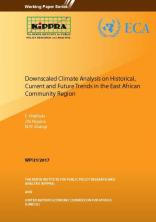WP21 Downscaled Climate Changes Scenarios

Understanding and conidence on climate change and its potential impacts have grown greatly over the last few years. The Inter-governmental Panel on Climate Change (IPCC) ifth assessment report (AR5) notes that climate change is unequivocal (IPCC, 2014). Studies by Anyah and Qiu (2012) and Endris et al. (2013) airm that rainfall in the Eastern Africa region remains highly variable, unreliable and likely associated with changes in the regional climate. Other observed evidence includes but not limited to the shift in the length of growing seasons and increased frequency of extreme events such as drought and loods. Changes in climate coupled with resource-based conlicts in Eastern Africa have signiicantly afected food security.
Climate models are suitable tools for assessing climate variability and change (Endris et al., 2013). The Global Climate Models (GCMs) have been used to simulate changes in atmospheric circulation (Shongwe et al., 2009). However, its coarse resolution (~100 -150km) makes the GCMs unable to capture the detailed processes at the regional level (Giorgi et al., 2009). The sub-grid scale processes which signiicantly afect climate include variations in vegetation, topography, soils, and coastlines. Efective adaptation strategies meant to respond to climate variability and change require reliable information at iner spatial and temporal resolution. Therefore, Regional Climate Model output is more suited to support understanding of local climate especially in regions such as Eastern Africa with complex processes (Sun et al., 2006). The Coordinated Regional Climate Downscaling Experiment (CORDEX) provides dynamically downscaled model output and thus high-resolution regional climate projections suitable for impact assessment at regional scales (Giorgi et al., 2009).
Therefore, the study aimed at analyzing downscaled information on historical and projected climate information over the East Africa Community.